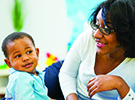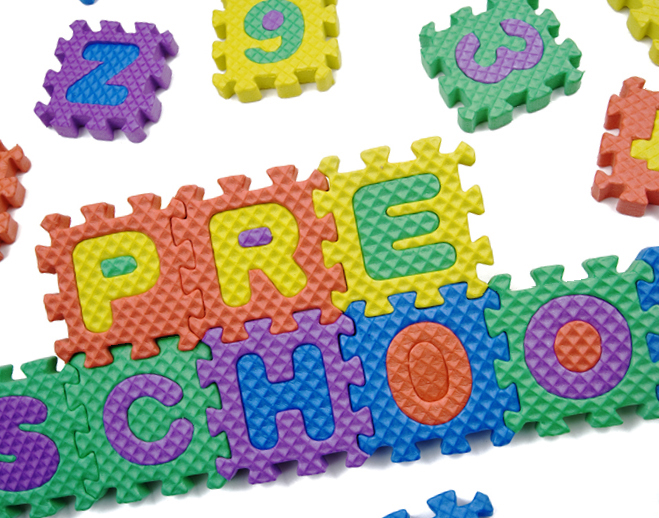Mealtime: Stop/Go
Lesson for:
Infants
Content Area:
Algebra
Geometry
Numbers and Operations
Routine:
Mealtime

Mealtime: Stop/Go
Lesson plan for infants 0 to 6 months
Step 1: Review developmental stage: 0 to 6 months.
Play: Infants begin by using their eyes to explore toys and then begin to use their hands and mouths to explore. Their play is primarily shaking, banging and mouthing. At the end of this stage, they begin to look for dropped toys and may find a partially hidden object.
Communication: Young infants recognize their parents and familiar caregivers. They smile and laugh during playful interactions such as peek-a-boo. They make early cooing and babbling sounds.
Motor: When placed on their tummies, infants learn to hold up their heads and reach for toys. They begin to reach and grasp for objects, beginning with the caregivers’ clothes and hair and then moving on to toys and objects. At the end of this stage, many infants may help hold their own bottles and help bring the bottles to their mouths. They may also begin to take pureed food from a spoon.
Step 2: Gather materials.
- Bottle
- Spoon
- Bowl with pureed food
Note: Small parts pose a choking hazard and are not appropriate for children age five or under. Be sure to choose lesson materials that meet safety requirements.
Step 3: Engage infant in lesson activities.
Mealtime: Use the words “GO” and “STOP” as you prepare food or bottles and as you feed the young infant. Gently say: “GO” when you start to warm the bottle and “STOP” when you pull it out of the warmer. Gently say: “GO” when you begin feeding the child and “STOP” when you STOP to burp or finish feeding. Engage the infant while you stir the food. Offer the infant a spoon to hold. Say: “Let’s stir the sweet potatoes. “GO!” Begin stirring. Count to 10 while you stir. Then say: “STOP!” Make the stirring seem like really hard work and sigh and act tired when you STOP stirring. Then repeat. Infants will love the playfulness of the STOP and GO stirring.

Mealtime: Stop/Go
Lesson plan for infants 6 to 12 months
Step 1: Review developmental stage: 6 to 12 months.
Play: At the beginning of this stage, play is mostly shaking, banging and mouthing toys. By the end of this stage, infants begin to combine objects that go together in play. They reach for and hold two objects and may begin to reach for a third. Many infants will look for dropped toys and find partially and completely hidden toys. Many infants enjoy taking objects out of containers and putting them back in.
Communication: At this age, infants respond when their names are called. They may turn their heads, make eye contact and sometimes smile and vocalize. They may look for family members and pets when called by name. They may respond to simple requests made with gestures, such as: “Come here.” They may understand “No” or “Stop.” They may lift their arms to be picked up, clap hands and wave bye-bye. They love to shout and squeal and may be babbling with many different sounds. They may be participating in and sometimes initiating peek-a-boo.
Motor: During this stage, many infants begin to sit by themselves and play. They begin to move by rolling, crawling and cruising. They pick up toys by using a raking motion with their whole hand and, by the end of this stage, they are using their fingers and thumbs to pick up small objects. They may feed themselves small bits of food.
Step 2: Gather materials.
- Bowl (with warm mashed food)
- Spoon
Note: Small parts pose a choking hazard and are not appropriate for children age five or under. Be sure to choose lesson materials that meet safety requirements.
Step 3: Engage infant in lesson activities.
Mealtime: Preparing meals offers lots of opportunities to teach the concept of STOP and GO. It also keeps little ones engaged while you prepare meals. Try these playful interactions: Practice blowing to cool warm food. Say: “The food is hot. Let’s blow to cool it down. GO!” Then start blowing. “STOP!” Then pull back from the bowl and STOP blowing. Repeat playfully with the infant until the food is cool. Engage the infant while you stir the food. Offer the infant a spoon to hold. Say: “Let’s stir the sweet potatoes. GO!” Begin stirring. Count to 10 while you stir. Then say: “STOP!” Make the stirring seem like really hard work and sigh and act tired when you STOP stirring. Then repeat. Infants will love the playfulness of the STOP and GO stirring. Holding a spoon and later pretending to stir in a bowl gives the infant the opportunity to actively participate as he/she learns STOP and GO.

Mealtime: Stop/Go
Lesson plan for infants 12 to 18 months
Step 1: Review developmental stage: 12 to 18 months.
Play: At the beginning of this stage, many infants are imitating the use of everyday objects such as cups and spoons. This moves into early pretend play, when the infant may feed you or pretend to drink from a cup or eat off of an empty spoon. They also are great imitators and may enjoy imitating daily activities. They may enjoy putting multiple objects into containers and systematically searching for hidden toys and objects. Many infants will pat pictures in books and sometimes vocalize while looking at books.
Communication: At the beginning of this stage, many infants begin to respond to one-step directions such as: “Give me the ball.” They may need gestures to help them understand the direction. At the end of this stage, many infants follow a related two-step direction without the help of gestures, such as: “Get the ball and give it to Daddy.” They may be pointing to ask for wants and needs and to ask you to name objects. At around 12 months of age, many infants say one to three words on their own and, by the end of this stage, may say up to 15 words or more. Many infants play turn-taking games at this stage.
Motor: At the beginning of this stage, many infants are crawling and cruising to get around and, by the end of this stage, infants are walking with good balance. They may also enjoy walking while carrying large objects and pulling toys. When given a crayon for the first time, they may mouth the crayon or mark the paper. By the end of this stage, many infants are scribbling on paper. They may be starting to scoop food with a spoon and actually get some to their mouths. Infants may also be using a straw or an open cup to drink.
Step 2: Gather materials.
- Bowl
- Spoon
- Warm food or pretend food
Note: Small parts pose a choking hazard and are not appropriate for children age five or under. Be sure to choose lesson materials that meet safety requirements.
Step 3: Engage infant in lesson activities.
Mealtime: Preparing meals offers lots of opportunities to teach the concept STOP and GO and keeps tots busy while you prepare meals. Try these playful interactions: Practice blowing to cool warm food. Say: “The food is hot. Let’s blow to cool it down. GO!” Hold the food so that both you and the infant can safely blow on it. Then start blowing. Really puff out your cheeks and blow hard. Say: “STOP!” Then pull back from the bowl and STOP blowing. Repeat playfully with the infant until the food is cool. Count the number of times that you blow together. If you are too busy preparing meals to hold the food out safely for the infant, then give the infant a bowl with pretend food. Have him “help” you cool this food down as you say: “GO!” and “STOP!”Stir food with the infant, using “GO” and “STOP.” Offer the infant a spoon to hold and a bowl with some real or pretend food. Say: “Let’s stir the sweet potatoes. GO!” Begin stirring. Count to 10 while you stir. Then say: “STOP!” Make the stirring seem like really hard work and sigh and act tired when you STOP stirring. Then repeat. Infants will love the playfulness of the STOP and GO stirring. Stirring real or pretend food gives infants the opportunity to actively participate as they learn STOP and GO.

Reflections on this lesson
How might you teach the math lesson STOP and GO during other daily activities and routines?
What books do you have in your child care setting that reinforce the math concept of STOP and GO?
What songs or finger plays do you typically use in your child care setting that reinforce the math concept of STOP and GO?
Comment on this lesson